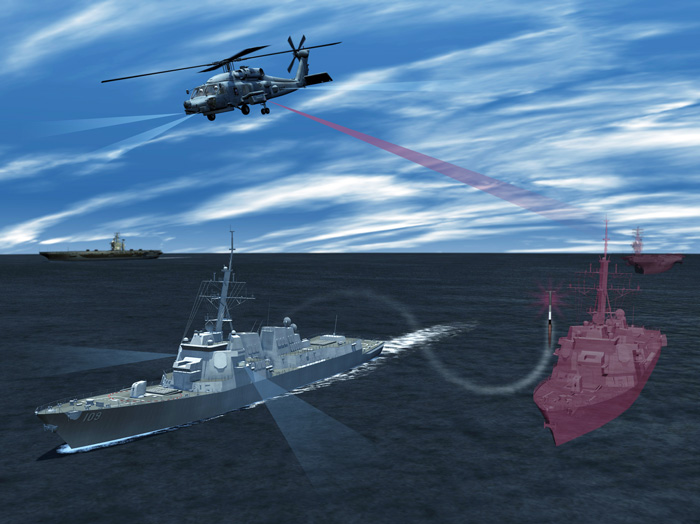
Electronic Warfare (EW) represents the ability to use the electromagnetic spectrum—signals such as radio, infrared or radar—to sense, protect, and communicate. At the same time, it can be used to deny adversaries the ability to either disrupt or use these signals.
Electronic Warfare is divided into three ( III ) major areas :
I . Electronic Attack
II. Electronic Protection
III . Electronic Support
X . I
Electronic ATTACK
Electronic attack ( EA ) is the discipline of attacking an adversary’s
access to the electromagnetic spectrum. Individual EA topics include:
• RADAR Electronic Attack (EA) vs. Communications Electronic Attack (EA)
• The Jamming System
• Polarization
• Jammer RF Spot Size
• Noise vs. False Targets
• Range
• The Jamming System
• Polarization
• Jammer RF Spot Size
• Noise vs. False Targets
• Range
Division of electronic warfare involving the use of electromagnetic energy, directed energy, or anti radiation weapons to attack personnel, facilities, or equipment with the intent of degrading, neutralizing, or destroying enemy combat capability and is considered a form of fires .
electronic attack (EA) is ivision of electronic warfare involving the use of electromagnetic energy, directed energy, or antiradiation weapons to attack personnel, facilities, or equipment with the intent of degrading, neutralizing, or destroying enemy combat capability and is considered a form of fires .
An electronic attack, most commonly referred to as an electromagnetic pulse (EMP), disrupts the reliability of electronic equipment through generating instantaneous high energy that overloads circuit boards, transistors, and other electronics. EMP effects can penetrate computer facility walls where they can erase electronic memory, upset software, or permanently disable all electronic components.
An electronic attack includes —
- Actions taken to prevent or reduce an enemy's effective use of the electromagnetic spectrum, such as jamming and electromagnetic deception.
- Employment of weapons that use either electromagnetic or directed energy as their primary destructive mechanism (lasers, radio frequency weapons, particle beams).
- Offensive and defensive activities including electronic countermeasures.
Electronic attack actions also include various electromagnetic deception techniques such as false target or duplicate target generation.
Activities related to electronic attack are either offensive or defensive and include —
- Countermeasures
- Electromagnetic deception
- Electromagnetic intrusion
- Electromagnetic jamming
- Electromagnetic pulse, and
- Electronic probing.
Offensive electronic attack 
Offensive electronic attack activities "are generally
conducted at the request and onset of friendly force engagement of the
enemy. In many cases, these activities suppress a threat for only a
limited period of time."
Examples of offensive electronic attacks include —
- Jamming enemy radar or electronic command and control systems.
- Using antiradiation missiles to suppress enemy air defenses (antiradiation weapons use radiated energy emitted from the target as their mechanism for guidance onto targeted emitters).
- Using electronic deception techniques to confuse enemy intelligence, surveillance, and reconnaissance systems.
- Using directed-energy weapons to disable an enemy's equipment or capability.
Defensive electronic attack
uses the electromagnetic spectrum to protect personnel, facilities, capabilities, and equipment. Examples include self-protection and other protection measures such as use of expendables (flares and active decoys), jammers, towed decoys, directed-energy infrared countermeasure systems, and counter-radio-controlled improvised-explosive-device systems .
X . II
Electronic counter measures
Electronic countermeasures (ECM) are division of electronic warfare involving actions taken to prevent or reduce an enemy's effective use of the electromagnetic spectrum through the use of electromagnetic energy .
Overview 
There are three subdivisions of electronic countermeasures : electronic jamming, electronic deception and electronic neutralization.
It may be used both offensively and defensively to deny targeting information to an enemy. The system may make many separate targets appear to the enemy, or make the real target appear to disappear or move about randomly. It is used effectively to protect aircraft from guided missiles.
Most air forces use ECM to protect their aircraft from attack. It has also been deployed by military ships and recently on some advanced tanks to fool laser/IR guided missiles. It is frequently coupled with stealth advances so that the ECM systems have an easier job. Offensive ECM often takes the form of jamming. Defensive ECM includes using blip enhancement and jamming of missile terminal homers.
X . III
Electromagnetic jamming
Symphony Block 40 is able to defeat current and emerging improvised explosive device (IED) threats and is designed to protect warfighters in an unpredictable battlespace. Photo from Lockheed Martin.
Electromagnetic jamming is he deliberate radiation, reradiation, or reflection of electromagnetic energy for the purpose of preventing or reducing an enemy’s effective use of the electromagnetic spectrum, and with the intent of degrading or neutralizing the enemy’s combat capability .
Electromagnetic radiation is a ubiquitous phenomenon that takes the form of self-propagating waves in
a vacuum or in matter. It consists of electric and magnetic field
components which oscillate in phase perpendicular to each other and
perpendicular to the direction of energy propagation. radiation made up of oscillating electric and magnetic fields and
propagated with the speed of light. Includes gamma radiation, X-rays,
ultraviolet, visible, and infrared radiation, and radar and radio waves .
Overview 
Electromagnetic radiation is classified into several types according to the frequency of its wave; these types include (in order of increasing frequency and decreasing wavelength): radio waves, microwaves, terahertz radiation, infrared radiation, visible light, ultraviolet radiation, X-rays and gamma rays. A small and somewhat variable window of frequencies is sensed by the eyes of various organisms; this is what we call the visible spectrum, or light.
The electromagnetic environnement (EME) is "the totality of electromagnetic phenomena existing at a given location : the resulting product of the power and time distribution, in various frequency ranges, of the radiated or conducted electromagnetic
emission levels that may be encountered by a military force, system, or
platform when performing its assigned mission in its intended
operational environment. It is the sum of the electromagnetic interference; electromagnetic pulse; hazards of electromagnetic radiation to personnel, ordnance, and volatile materials; and natural phenomena effects of lightning and precipitation static .
X . IIII
Electromagnetic pulse
Symphony Block 40 is an open architecture design that incorporates cutting edge technology to address new and emerging threats. Photo from Lockheed Martin
An electromagnetic pulse (EMP) is the electromagnetic radiation from a strong electronic pulse, most commonly caused by a nuclear explosion that may couple with electrical or electronic systems to produce damaging current and voltage surges .
1 or more pulses of electromagnetic energy emitted by a device capable of disabling or disrupting operation of, or destroying, electronic devices or communications networks, including hardware, software, and data, by means of such a pulse .
Impact on power grid 
"Electromagnetic risks caused by a man-made electromagnetic pulse
(EMP) or a naturally occurring solar weather event could have a
significant impact on the nation's electric grid as well as other infrastructure sectors that depend on electricity, such as communications. The impact of these events could lead to power outages over broad geographic areas for extended durations."
"EMPs can cause voltage and current surges which can severely damage electrical equipment and systems. A high-altitude nuclear explosion could cause an EMP which could severely impair an electric power system not shielded from the effects of an EMP.
Impact on Telecommunications 
"Electromagnetic pulse (EMP) attacks present a less significant direct threat to telecommunications than it does to the National Power grid, but would nevertheless disrupt or damage a functionally significant fraction of the electronic circuits in the Nation's telecommunications systems
in the region exposed to EMP (which could include most of the United
States). EMP attacks could damage a functionally significant portion of
the Electric Power Grid, resulting in prolonged power- and synergistic
system-outages."X . IIIII
Electronic probing
An electronic probing is intentional radiation designed to be introduced into the devices or systems of potential enemies for the purpose of learning the functions and operational capabilities of the devices or systems .
X . IIIIII
Command and control system

A command and control system is the facilities, equipment, communications, procedures, and personnel essential to a commander for planning, directing, and controlling operations of assigned and attached forces pursuant to the missions assigned .
X . IIIIIII
Electronic deception
Electronic deception (ED) is the deliberate radiation, reradiation, alteration, suppression, absorption, denial, enhancement, or reflection of electromagnetic energy in a manner intended to convey misleading information and to deny valid information to an enemy or to enemy electronics-dependent weapons.
Overview
Among the types of electronic deception are:
- Manipulative electronic deception: Actions to eliminate revealing or convey misleading, telltale indicators that may be used by hostile forces.
- Simulative electronic deception: Actions to represent friendly notional or actual capabilities to mislead hostile forces.
- Imitative electronic deception: The introduction of electromagnetic energy into enemy systems that imitates enemy emissions.
X . IIIIIIIII












Tidak ada komentar:
Posting Komentar